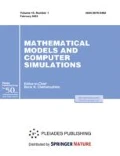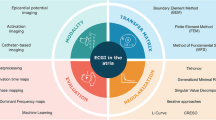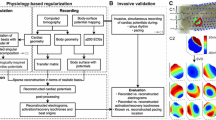Abstract
The problem of determining the point on the heart surface (projection) nearest to the arrhythmogenic focus, which is located inside the heart, is considered. Localization of this point is crucial for a successful cardiac ablation procedure. The sought projection is calculated on the basis of solving the inverse electrocardiography problem, which is a generalization of the Cauchy problem for the Laplace equation. The inverse electrocardiography problem is solved by the boundary integral equation and Tikhonov regularization methods. Examples of test computations are demonstrated, and the results of processing real electrophysiological data are presented and compared with the medical observation data.
Similar content being viewed by others
References
S. K. Stephen Huang and M. A. Wood, Catheter Ablation of Cardiac Arrhythmias (Elsevier, 2010).
R. Barr and M. Spek, Solutions of the Inverse Problems Expresses Directly in the Form of a Potential (Meditsina, Moscow, 1979) [in Russian].
A. M. Denisov, E. V. Zakharov, A. V. Kalinin, and V. V. Kalinin, “Application of the Tikhonov Regularization Method for Numerical Solution of the Inverse Electrocardiography Problem,” Vestn. Mosk. Univ., Ser. 15(2), 5–10 (2008).
A. M. Denisov, E. V. Zakharov, A. V. Kalinin, and V. V. Kalinin, “Numerical Methods for Solving Some Inverse Problems of Cardiac Electrophysiology,” Differents. Uravn. 45(7), 1014–1022 (2009).
E. V. Zakharov and A. V. Kalinin, “Numerical Solution of the Three-Dimensional Dirichlet Problem in Piecewise-Homogeneous Medium by the Method of Boundary Integral Equations,” Zh. Vychisl. Mat. Mat. Fiz. 49(7), 1197–1206 (2009).
A. M. Denisov, E. V. Zakharov, A. V. Kalinin, and V. V. Kalinin, “Numerical Solution of the Inverse Electro-ardiography Problem in a Medium with a Piecewise-Constant Conductivity,” Zh. Vychisl. Mat. Mat. Fiz. 7, 1233–1239 (2010).
A. V. Kalinin, “An Iterative Algorithm for Solving the Inverse electrocardiography Problem with a Piecewise-Constant Conductivity,” in Applied Mathematics and Informatics, no. 34 (Izd-vo MGU, Moscow, 2010), pp. 35–40.
E. V. Zakharov, A. G. Davydov, and I. V. Khaleeva, “Integral Equations with Hadamard Kernels in Diffractrion Problems,” in Urgent Problems of Applied Mathematics (Moscow: Izd-vo MGU, Moscow, 1989), pp. 118–127.
A. N. Tikhonov and V. Ya. Arsenin, Solution of Ill-Posed Problems (Nauka, Moscow, 1986) [in Russian].
A. Sutradhar, G. H. Paulino, and L. J. Gray, Symmetric Galerkin Boundary Element Method (Springer, 2008).
A. N. Tikhonov and A. A. Samarskii, Equations of Mathematical Physics (Izd-vo MGU, Moscow, 1998) [in Russian].
G. M. Vainikko, I. K. Lifanov, and L. N. Poltavskii, Numerical Methods in Hypersingular Integral Equations and their Applications (Yanus, Moscow, 2001) [in Russian].
Author information
Authors and Affiliations
Corresponding author
Additional information
Original Russian Text © A.M. Denisov, E.V. Zakharov, A.V. Kalinin, 2012, published in Matematicheskoe Modelirovanie, 2012, Vol. 24, No. 4, pp. 22–30.
Rights and permissions
About this article
Cite this article
Denisov, A.M., Zakharov, E.V. & Kalinin, A.V. Method for determining the projection of an arrhythmogenic focus on the heart surface, based on solving the inverse electrocardiography problem. Math Models Comput Simul 4, 535–540 (2012). https://doi.org/10.1134/S207004821206004X
Received:
Published:
Issue Date:
DOI: https://doi.org/10.1134/S207004821206004X




